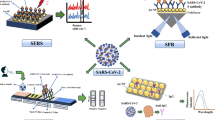Abstract
A CRISPR-based nucleic acid detection platform, termed LACD (loop-mediated isothermal amplification coupled with CRISPR-Cas12a-mediated diagnostic) has been developed. In the LACD system, the core primer used in conventional LAMP (forward inner primer or backward inner primer) was engineered to contain a PAM (protospacer adjacent motif) site (TTTT) at the linker region. As a result, the LAMP amplicons contained a specific PAM site for CRISPR-Cas12a recognition. At the CRISPR-mediated detection stage, the resulting LAMP products can activate the corresponding CRISPR-Cas12a effector upon the formation of the CRISPR-Cas12a/gRNA/target DNA complex. The single-strand DNA (ssDNA) reporter molecules are then rapidly cleaved due to the CRISPR-Cas12a’s trans-enzyme activity. The ssDNA degradation can then be visualized on a lateral flow biosensor or measured by a real-time fluorescence instrument. Our LACD assay allows any target sequence to be detected (even targets which do not contain any PAM sites) as long as they met the design requirement for LAMP. The feasibility of the LACD methodology for nucleic acid detection was validated on the Mycobacterium tuberculosis complex (MTC). This proof-of-concept assay can be reconfigured to detect a variety of target sequences by redesigning the engineered LAMP primers.
Graphical abstract





Similar content being viewed by others
References
Obande GA, Singh KKB (2020) Current and future perspectives on isothermal nucleic acid amplification technologies for diagnosing infections. Infect Drug Resist 13:455–483
Wang Y, Wang Y, Ma A-J, Li D-X, Luo L-J, Liu D-X, Jin D, Liu K, Ye C-Y (2015). Rapid and sensitive isothermal detection of nucleic-acid sequence by multiple cross displacement amplification. Scientific Reports 5(1):1–16
Wang Y, Jiao W-w, Wang Y, Wang Y-c, Shen C, Qi H, Shen A-D (2020) Graphene oxide and self-avoiding molecular recognition systems-assisted recombinase polymerase amplification coupled with lateral flow bioassay for nucleic acid detection. Microchim Acta 187:1–11
Zhao Y, Chen F, Li Q, Wang L, Fan C (2015) Isothermal amplification of nucleic acids. Chem Rev 115:12491–12545
Zhu X, Wang X, Han L, Chen T, Wang L, Li H, Li S, He L, Fu X, Chen S, Xing M, Chen H, Wang Y (2020) Multiplex reverse transcription loop-mediated isothermal amplification combined with nanoparticle-based lateral flow biosensor for the diagnosis of COVID-19. Biosens Bioelectron 166:112437
Li S, Jiang W, Huang J, Liu Y, Ren L, Zhuang L, Zheng Q, Wang M, Yang R, Zeng Y, Wang Y (2020) Highly sensitive and specific diagnosis of COVID-19 by reverse transcription multiple cross-displacement amplification-labelled nanoparticles biosensor. European Respiratory Journal 56(6)
Joung J, Ladha A, Saito M, Segel M, Bruneau R, Huang M-LW, Kim N-G, Yu X, Li J, Walker BD (2020) Point-of-care testing for COVID-19 using SHERLOCK diagnostics. MedRxiv
Wang Y, Wang Y, Li D, Xu J, Ye C (2018) Detection of nucleic acids and elimination of carryover contamination by using loop-mediated isothermal amplification and antarctic thermal sensitive uracil-DNA-glycosylase in a lateral flow biosensor: application to the detection of Streptococcus pneumoniae. Microchim Acta 185:212
Koonin EV, Makarova KS, Zhang F (2017) Diversity, classification and evolution of CRISPR-Cas systems. Curr Opin Microbiol 37:67–78
Huang Z, Tian D, Liu Y, Lin Z, Lyon CJ, Lai W, Fusco D, Drouin A, Yin X, Hu T, Ning B (2020) Ultra-sensitive and high-throughput CRISPR-p owered COVID-19 diagnosis. Biosens Bioelectron 164:112316
Aman R, Mahas A, Mahfouz M (2020) Nucleic acid detection using CRISPR/Cas biosensing technologies, ACS Synthetic Biology
Mukama O, Wu J, Li Z, Liang Q, Yi Z, Lu X, Liu Y, Liu Y, Hussain M, Makafe GG (2020) An ultrasensitive and specific point-ofcare CRISPR/Cas12 based lateral flow biosensor for the rapid detection of nucleic acids 159:112143
Chen JS, Ma E, Harrington LB, Da Costa M, Tian X, Palefsky JM, Doudna JA (2018) CRISPR-Cas12a target binding unleashes indiscriminate single-stranded DNase activity. Science 360:436–439
Harrington LB, Burstein D, Chen JS, Paez-Espino D, Ma E, Witte IP, Cofsky JC, Kyrpides NC, Banfield JF, Doudna JA (2018) Programmed DNA destruction by miniature CRISPR-Cas14 enzymes. Science 362:839–842
Li S-Y, Cheng Q-X, Wang J-M, Li X-Y, Zhang Z-L, Gao S, Cao R-B, Zhao G-P, Wang J (2018) CRISPR-Cas12a-assisted nucleic acid detection. Cell Discov 4:1–4
Zhu X, Wang X, Li S, Luo W, Zhang X, Wang C, Chen Q, Yu S, Tai J, Wang Y (2021) Rapid, ultrasensitive, and highly specific diagnosis of COVID-19 by CRISPR-based detection. ACS Sensors, 6(3), 881–888
Notomi T, Okayama H, Masubuchi H, Yonekawa T, Watanabe K, Amino N, Hase T (2000) Loop-mediated isothermal amplification of DNA. Nucleic Acids Res 28:e63-e63
Aryan E, Makvandi M, Farajzadeh A, Huygen K, Bifani P, Mousavi S-L, Fateh A, Jelodar A, Gouya M-M, Romano M (2010) A novel and more sensitive loop-mediated isothermal amplification assay targeting IS6110 for detection of Mycobacterium tuberculosis complex. Microbiol Res 165:211–220
Wang Y, Deng J, Liu D, Wang Y, Xu J, Ye C (2017) Nanoparticles-based lateral flow biosensor coupled with multiple cross displacement amplification Plus for simultaneous detection of nucleic acid and prevention of carryover contamination. Sensors Actuators B Chem 255:3332–3343
Afghani B, Stutman HR (1996) Polymerase chain reaction for diagnosis ofM. tuberculosis: comparison of simple boiling and a conventional method for DNA extraction. Biochem Mol Med 57:14–18
Acknowledgements
We would like to thank Laurence Don Wai Luu (School of Biotechnology and Biomolecular Science, University of New South Wales, Sydney, Australia) for linguistic assistance during the revision of this manuscript.
Funding
This work was supported by Cultivation Fund Project of the National Natural Science Foundation in Beijing Children’s Hospital, Capital Medical University (GPMS201904), and Qian Ke He Support Plan [2019]2822.
Author information
Authors and Affiliations
Corresponding authors
Ethics declarations
Conflict of interest
The authors declare no competing interests.
Additional information
Publisher’s note
Springer Nature remains neutral with regard to jurisdictional claims in published maps and institutional affiliations.
Supplementary information
ESM 1
(DOCX 4192 kb)
Rights and permissions
About this article
Cite this article
Wang, Y., Li, J., Li, S. et al. LAMP-CRISPR-Cas12-based diagnostic platform for detection of Mycobacterium tuberculosis complex using real-time fluorescence or lateral flow test. Microchim Acta 188, 347 (2021). https://doi.org/10.1007/s00604-021-04985-w
Received:
Accepted:
Published:
DOI: https://doi.org/10.1007/s00604-021-04985-w




